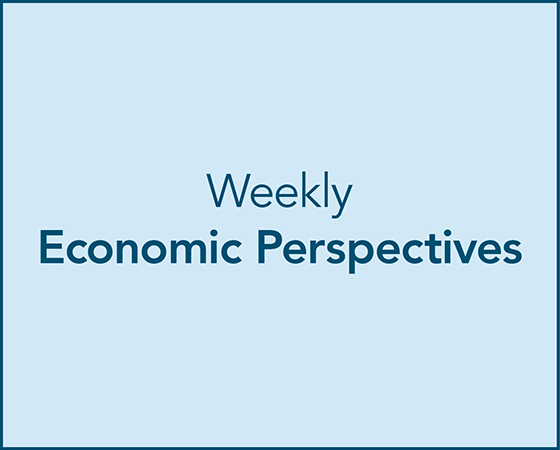Economic Summary
It was a relatively quiet week for economic news. What we learned was:
Leading Index
The leading index deteriorated further but highlighted the bifurcation between soft data (i.e., sentiment) and hard data. The decline was driven by deteriorating sentiment, not hard data.
Mortgage Activity
Mortgage applications fell 5.1% as higher mortgage rates drove a 5% decrease in both purchase and refinancing applications.
Perspectives
Part of doing business is to plan for and budget what you expect to happen in the future. Basically, any business owner is a forecaster by default. For small businesses this is especially true because being right or wrong about your expectations for the future may have an outsized effect on a small business owner compared to a large business or a mega corporation. Today's Perspectives section examines the difference between what small business owners expected to happen in six months versus what actually happened over the past five years.
The National Federation of Independent Business (NFIB) released the April results for its Small Business Optimism Index. The index deteriorated for a second straight month. The valuable information from the report is insight that we can gain about the forecasts from small business owners. What the tables below show:
-
Expectations for six months in the future for eight survey categories
-
Actual results for the categories at the future date that was forecast
-
Error level (difference between the expectation and the actual result)
-
There is a table for October (forecast month) and April (actual result) for each of the past five years.
What the tables below show is that forecasting is an art form at best. This should not be surprising, especially with all the changing dynamics that have occurred within the economy over the past five years. Highlights from the tables:
-
Small business owners are very accurate in their assessment of future loan availability as the error level is consistently at or near zero.
-
Small business owners consistently overestimate future inventory levels as the error level was negative (lower than expected) for each year.
-
Small business owners consistently overestimate the future level of jobs creation as the error level was negative for all years.
-
Small business owners consistently underestimate their future level of capital spending as the error level was positive (higher than expected) for each year.
-
The remaining four categories had mixed results with both positive and negative error levels.
Additional information garnered from the NFIB report is a sign of the bifurcation between how small business owners are feeling about the future versus what they are currently experiencing.
-
The composite index is a combination of current results and future expectations. Even though the composite index declined, it was driven by a negative outlook for the future.
-
Current results for the eight categories listed in the tables show that five out of the eight categories experienced improvement from March's results.
-
Future expectations for the eight categories show that six out of the eight categories experienced deterioration from March's results.
The negative results for future expectations are most likely a reflection of small business owners being unhappy with the current uncertainty over fiscal policy and consumer behavior and the challenges of trying to plan for the future as a result.
-
One of the factors that small business owners hate is a lack of certainty or stability in policies and regulations that affect their business.
-
Small business owners may also be worried that the continued decline in consumer sentiment surveys may translate into inaction and reduced spending from the consumer.
As time progresses, what we must to monitor is whether current fiscal policy helps or hurts small businesses.
-
Uncertainty, volatility, and/or chaos may or may not turn out to be an effective negotiating strategy, but it may take time to play out.
-
If the strategy turns out to be effective, but takes time, small businesses, in general, may not have the financial resources that large businesses and mega corporations have to withstand the length time it takes to experience the benefits. By the time any benefits may result, the small business may be out of business.
-
I may sound like a broken record, but small business is the lifeblood for cities and towns. As a result, we should all care about the impact to small businesses of fiscal policy. Communicating with your representatives in Congress remains critical to deliver that message and provide real life examples.
|
Category |
10/31/24: Expected 4/30/25 |
Actual: 4/30/25 |
Error |
|
Earnings Increase |
-5 |
-21 |
-16 |
|
Sales Increase |
-4 |
-8 |
-4 |
|
Inventory Increase |
-2 |
-5 |
-3 |
|
Jobs Increase |
15 |
1 |
-14 |
|
Compensation Increase |
23 |
33 |
-10 |
|
Price Increase |
26 |
25 |
+1 |
|
Capital Expenditures |
+22 |
58 |
+36 |
|
Loan Availability |
-6 |
-7 |
-1 |
|
Category |
10/31/23: Expected 4/30/24 |
Actual: 4/30/24 |
Error |
|
Earnings Increase |
-43 |
-27 |
+16 |
|
Sales Increase |
-10 |
-13 |
-3 |
|
Inventory Increase |
0 |
-6 |
-6 |
|
Jobs Increase |
17 |
0 |
-17 |
|
Compensation Increase |
24 |
38 |
-14 |
|
Price Increase |
33 |
21 |
+7 |
|
Capital Expenditures |
24 |
56 |
+32 |
|
Loan Availability |
-9 |
-9 |
-0- |
|
Category |
10/31/22: Expected 4/30/23 |
Actual: 4/30/23 |
Error |
|
Earnings Increase |
-46 |
-23 |
+23 |
|
Sales Increase |
-13 |
-9 |
+4 |
|
Inventory Increase |
2 |
-7 |
-9 |
|
Jobs Increase |
20 |
-2 |
-18 |
|
Compensation Increase |
32 |
40 |
+12 |
|
Price Increase |
34 |
33 |
-1 |
|
Capital Expenditures |
23 |
+56 |
+33 |
|
Loan Availability |
-8 |
-6 |
+2 |
|
Category |
10/31/21: Expected 4/30/22 |
Actual: 4/30/22 |
Error |
|
Earnings Increase |
-37 |
-17 |
+20 |
|
Sales Increase |
-0- |
+3 |
+3 |
|
Inventory Increase |
8 |
4 |
-4 |
|
Jobs Increase |
26 |
-2 |
-24 |
|
Compensation Increase |
32 |
46 |
+14 |
|
Price Increase |
51 |
63 |
+12 |
|
Capital Expenditures |
31 |
54 |
+17 |
|
Loan Availability |
-4 |
-4 |
-0- |
|
Category |
10/31/20: Expected 4/30/21 |
Actual: 4/30/21 |
Error |
|
Earnings Increase |
27 |
-7 |
-20 |
|
Sales Increase |
11 |
3 |
-8 |
|
Inventory Increase |
12 |
-2 |
-14 |
|
Jobs Increase |
18 |
1 |
-17 |
|
Compensation Increase |
18 |
31 |
+13 |
|
Price Increase |
20 |
36 |
+16 |
|
Capital Expenditures |
27 |
57 |
+30 |
|
Loan Availability |
-4 |
-3 |
+1 |

Steve is the Economist for Washington Trust Bank and holds a Chartered Financial Analyst® designation with over 40 years of economic and financial markets experience.
Throughout the Pacific Northwest, Steve is a well-known speaker on the economic conditions and the world financial markets. He also actively participates on committees within the bank to help design strategies and policies related to bank-owned investments.




